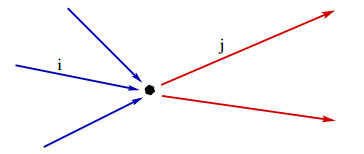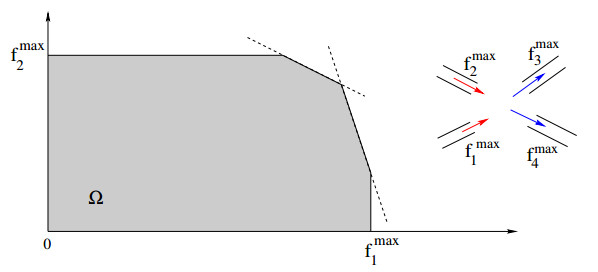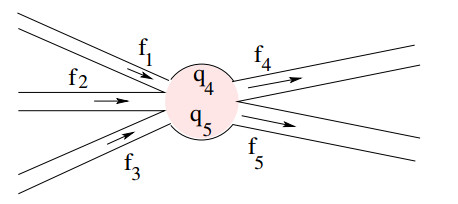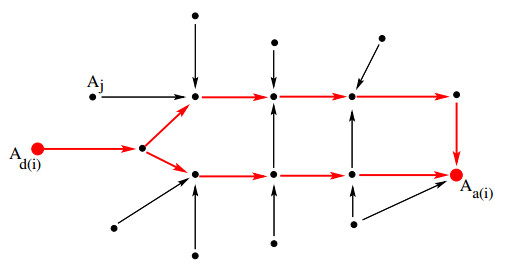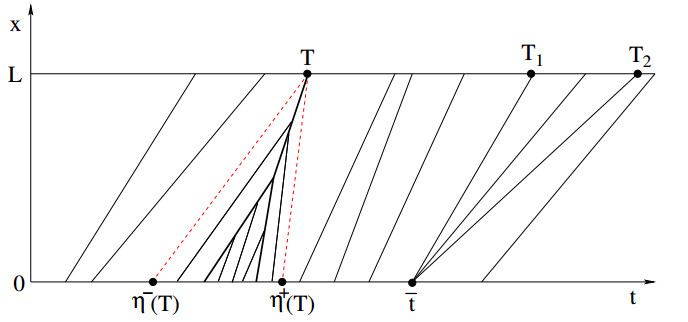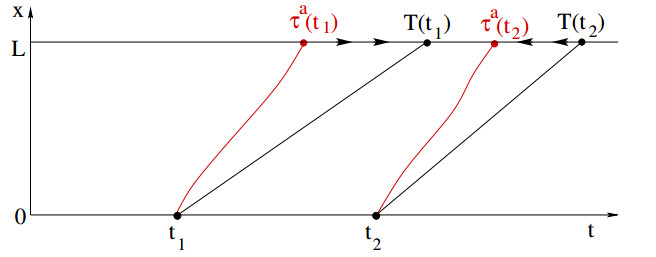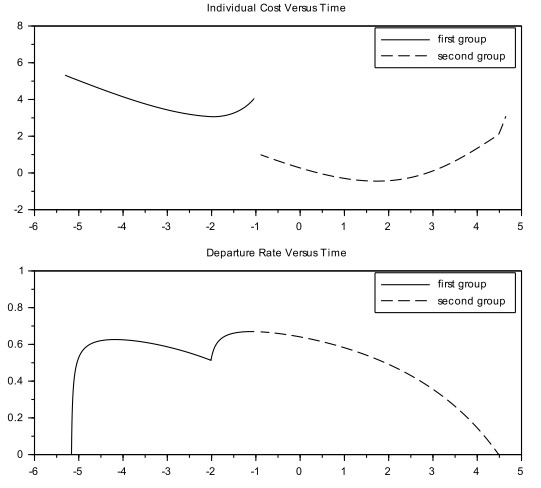The first part of this paper contains a brief introduction to conservation law models of traffic flow on a network of roads. Globally optimal solutions and Nash equilibrium solutions are reviewed, with several groups of drivers sharing different cost functions. In the second part we consider a globally optimal set of departure rates, for different groups of drivers but on a single road. Necessary conditions are proved, which lead to a practical algorithm for computing the optimal solution.
1.
Introduction
Macroscopic models of traffic flow, first introduced in [26,28], have now become a topic of extensive research. On a single road, the evolution of the traffic density can be described by a scalar conservation law. In order to extend the model to a whole network of roads, additional boundary conditions must be inserted, describing traffic flow at each intersection; see [10,16,20,21,23,24] or the survey [4]. A major eventual goal of these models is to understand traffic patterns, determined by the behavior of a large number of drivers with different origins and destinations.
In a basic setting, one can consider N groups of drivers, say G1,…,GN. Drivers from each group have the same origin and destination, and a cost which depends on their departure and arrival time. For such a model, two kind of solutions are of interest:
− The Nash equilibrium solution, where each driver chooses his own departure time and route to destination, in order to minimize his own cost.
− The global optimization problem, where a central planner seeks to schedule all departures in order to minimize the sum of all costs.
In general, these criteria determine very different traffic patterns. To fix the ideas, let t↦ui(t), i=1,…,N, be the departure rate of drivers of the i-th group, so that
yields the total number of these drivers who depart before time t. We recall that the support of ui, denoted by Supp(ui), is the closure of set of times t where ui(t)>0.
Roughly speaking, the two above solutions can be characterized as follows.
(Ⅰ) In a Nash equilibrium, all drivers within the same group pay the same cost. Namely, there exists constants K1,…,KN such that
● every driver of the i-th group, departing at a time t∈Supp(ui) bears the cost Ki.
● if a driver of the i-th group were to depart at any time t∈IR (possibly outside the support of ui), he would incur in a cost ≥Ki.
(Ⅱ) For a global optima, there exist constants C1,…,Cn (where Ci is the marginal cost for adding one more driver of the i-th group) such that
● If one additional driver of the i-th group is added at any time t∈Supp(ui), then the total cost increases by Ci.
● If one additional driver of the i-th group is added at any time t∈IR (possibly outside the support of ui), then the increase in the total cost is greater or equal to Ci.
At an intuitive level, these conditions are easy to explain. In Figure 1(left), the function Γi(t) denotes the cost to an i-driver departing at time t. If Γi did not attain its global minimum simultaneously at all points t∈[a,b]=Supp(ui), then we could find times t1∈[a,b] and t2∈IR such that Γi(t2)<Γi(t1). In this case, the driver departing at time t1 could lower his own cost choosing to depart at time t2 instead. This contradicts the definition of equilibrium.
In Figure 1(right), the function Λi(t) denotes the marginal cost for inserting one additional driver of the i-th family, departing at time t. This accounts for the additional cost to the new driver, and also for the increase in the cost to all other drivers who are slowed down by the presence of one more car on the road. If Λi did not attain its global minimum at all points in [c,d]=Supp(ui), then we could find times t1∈[c,d] and t2∈IR such that Λi(t2)<Λi(t1). In this case we could consider a new traffic pattern, with one less driver departing at time t1 and one more departing at time t2. This would achieve a smaller total cost, contradicting the assumption of optimality.
While the criterion (Ⅰ) for an equilibrium solution is easy to justify, a rigorous proof of the necessary condition (Ⅱ) for a global optimum faces considerable difficulties. Indeed, to compute the ``marginal cost" for adding one more driver, one should differentiate the solution of a conservation law w.r.t. the initial data (or the boundary data). As it is well known, in general one does not have enough regularity to carry out such a differentiation. To cope with this difficulty one can introduce a ``shift differential", describing how the shock locations change, depending on parameters. See [8,9,13,27,30] for results in this direction.
The first part of this paper contains an introduction to macroscopic models of traffic flow on a network of roads. Section 2 starts by reviewing the classical LWR model for traffic flow on a single road, in terms of a scalar conservation law for the traffic density. We then discuss various boundary conditions, modeling traffic flow at an intersection. Finally, given a cost function depending on the departure and arrival times of each driver, we review the concepts of globally optimal solution and of Nash equilibrium solution.
The second part of paper contains original results. We consider here N groups of drivers traveling along the same road, but with different departure and arrival costs. We seek departure rates u1(⋅),…,uN(⋅) which are globally optimal. Namely, they minimize the sum of all costs to all drivers. A set of necessary conditions for optimality is derived, thus extending the result in [5] to the case where several groups of drivers are present. Relying on these conditions, in the last section we introduce an algorithm that numerically computes such globally optimal solutions.
For an introduction to the general theory of conservation laws we refer to [3,19,29]. A more comprehensive discussion of various models of traffic flow can be found in [1,2,18,20].
2.
Conservation law models for traffic flow
2.1. Traffic flow on a single road
According to the classical LWR model [26,28], traffic density on a single road can be described in terms of a scalar conservation law
Here t is the time, while x∈IR is the space variable along the road. Moreover
● ρ is the traffic density, i.e., the number of cars per unit length of the road.
● v=v(ρ) is the velocity of cars, which we assume depends only on the traffic density.
● f=f(ρ) is the flux, i.e., the number of cars crossing a point x along the road, per unit time. We have the identity
As shown in Figure 2, the velocity should be a decreasing function of the car density. Concerning the flux function, a natural set of assumptions is
Here ρjam is the maximum density of cars allowed on the k-th road. This corresponds to bumper-to-bumper packing, where no car can move.
Smooth solutions of the conservation law (2.1) can be computed by the classical method of characteristics. By the chain rule, one obtains
Hence, if t↦x(t) is a curve such that
then the equation (2.3) yields
In other words, the density is constant along each characteristic curve satisfying (2.4). Notice that the assumptions (2.2) imply the inequality
With reference to Figure 2, let ρmax be the density at which the flux is maximum. We say that a state ρ is
● free, if ρ<ρmax, hence the characteristic speed f′(ρ) is positive,
● congested, if ρ>ρmax, hence the characteristic speed f′(ρ) is negative.
Due to the non-linearity of the flux function f, it is well known that solutions can develop shocks in finite time. The conservation law (2.1) must thus be interpreted in distributional sense. For the general theory of entropy weak solutions to conservation laws, we refer to [3,29].
2.2. Traffic flow at road intersections
To model vehicular traffic on an entire network of roads, the conservation laws describing traffic flow on each road must be supplemented with boundary conditions, describing the behavior at road intersections.
Consider an intersection, say with m incoming roads i∈{1,…,m}=I and n outgoing roads j∈{m+1,…,m+n}=O, see Figure 3. We shall use the space variable x∈]−∞,0] for incoming roads and x∈[0,+∞[ for outgoing roads. Throughout the following we assume that the density of traffic on each road is governed by a conservation law
where the flux function fk satisfies (2.2), for every k=1,…,m+n.
An appropriate model must depend on various parameters, namely
● ci = relative priority of drivers arriving from road i.
● θij = fraction of drivers from road i that turn into road j.
For example, if the intersection is regulated by a crosslight, ci could measure the fraction of time when drivers from road i get green light, on average. It is natural to assume
Boundary conditions should determine the limit values of the traffic density on each of the m+n roads meeting at the intersection:
At first sight, one might guess that m+n conditions will be required. However, this is not so, because on some roads the characteristics move toward the intersection. For these roads, the limits in (2.7) are already determined by integrating along characteristics. Boundary conditions are required only for those roads where the characteristics move away from the origin. Recalling the definition of free and congested states, we thus have
It now becomes apparent that, to assign a meaningful set of boundary conditions, several different cases must be considered.
To circumvent these difficulties, an alternative approach developed by Coclite, Garavello, and Piccoli [16,21,22] relies on the construction of a Riemann Solver. Instead of assigning a variable number of boundary conditions, here the idea is to introduce a rule for solving all Riemann problems (i.e., the initial-value problems where at time t=0 the densities ρk and turning preferences θij are constant along each road). Relying on front-tracking approximations, under suitable conditions one can prove that the solutions with general initial data are also uniquely determined.
We briefly review the main steps of this construction, for the constant initial data
Step 1. Determine the maximum flux fmaxi that can exit from each incoming road i∈I.
As shown in Figure 4, this is computed by
Step 2: Determine the maximum flux fmaxj that can enter each outgoing road j∈O.
As shown in Figure 5, this is computed by
Step 3: Given the maximum incoming and outgoing fluxes fmaxi, fmaxj, and the turning preferences θij, determine the region of admissible incoming fluxes (see Figure 6)
Step 4. To construct a Riemann solver, it now suffices to give a rule for selecting a point ˉω=(f1,…,fm) in the feasible region Ω. In general, this rule will depend on the priority coefficients c1,…,cm assigned to incoming roads. Observe that, as soon as the incoming fluxes fi, i∈I, are given, the outgoing fluxes are uniquely determined by the identities
Various ways to define a Riemann Solver are illustrated by the following examples.
Example 1: Given priority coefficients c1,…,cm, following [16] one can choose the vector of incoming fluxes
In particular, if c1=⋯=cm=1m, this means we are maximizing the total flux through the intersection (see Figure 7(left)).
Since in (2.10) we are maximizing a linear function over a polytope, in some cases the maximum can be attained at multiple points. This somewhat restricts the applicability of this model. An alternative model, with better continuity properties, is considered below.
Example 2: Given positive coefficients c1,…,cm as in (2.6), consider the one-parameter curve
where
As shown in Figure 7(right), we then choose the vector of incoming fluxes
where
Example 3 : To model an intersection with two incoming and two outgoing roads, where road 2 has a stop sign, we choose the point ¯ω=(f1,f2) according to the following rules (see Figure 8).
According to (2.13), as many cars as possible are allowed to arrive from road 1. According to (2.14), if any available space is left, cars arriving from road 2 are allowed through the intersection.
2.3. Intersection models with buffers
Having defined a way to solve each Riemann problem, a major issue is whether the Cauchy problem with general initial data is well posed. Assuming that the turning preferences θij remain constant in time, some results in this direction can be found in [16].
We remark, however, that in general these turning preferences may well vary in time. One should thus regard θij=θij(t,x) as variables. Assuming that drivers know in advance their itinerary, the conservation of the number of drivers on road i that will eventually turn into road j is expressed by the additional conservation law
Combining (2.15) with the conservation law
one obtains a linear transport equation for each of the quantities θij, namely
A surprising counterexample constructed in [14] shows that, for a very general class of Riemann Solvers, one can construct measurable initial data ρi(0,⋅), ρj(0,⋅), and θij(0,⋅), so that the Cauchy problem has two distinct entropy-admissible solutions.
The ill-posedness of these model equations represents a serious obstruction, toward the existence of globally optimal traffic patterns, or Nash equilibria, on a general network of roads. To cope with this difficulty, in [10] an alternative model was proposed, for traffic flow at an intersection. Namely, it is assumed that the junction contains a buffer (say, a traffic circle), as shown in Figure 9. Incoming cars are admitted at a rate depending of the amount of free space left in the buffer, regardless of their destination. Once they have entered the intersection, cars flow out at the maximum rate allowed by the outgoing road of their choice.
More precisely, consider a constant M>0, describing the maximum number of cars that can occupy the intersection at any given time, and constants ci>0, i∈I, accounting for priorities given to different incoming roads. For j∈O, at any time t we denote by qj(t)∈[0,M] the number of cars, already within the buffer, that seek to turn into road j.
As before, let fmaxi and fmaxj the maximum fluxes that can exit from road i∈I, or can enter into road j∈O. We then require that the incoming fluxes fi satisfy
In addition, the outgoing fluxes fj should satisfy
Having determined the incoming and outgoing fluxes fi, fj, the time derivatives of the queues qj are then computed by
The well-posedness of the intersection model with buffers, for general L∞ data, was proved in [10].
It is interesting to understand the relation between the intersection model with buffer, and the models based on a Riemann Solver. The analysis in [12] shows that, letting the size of the buffer M→0, the solution of the problem with buffers converges to the solution determined by the Riemann Solver at (2.11) and (2.12), described in Example 2.
2.4. Optima and equilibria on a network of roads
Consider a network of roads, with several intersections. We call γk, k=1,…,ˉk the arcs corresponding to the various roads, and A1,…,Aν the nodes corresponding to intersections. It is assumed that, on the k-th road, the flux function has the form fk(ρ)=ρvk(ρ), with vk a decreasing function of the density. As in the previous sections, traffic flow at each intersection can be modeled in terms of a Riemann Solver, or by means of a buffer.
We consider N groups of drivers with different origins and destinations, and possibly different departure and arrival costs. As shown in Figure 10:
● Drivers in the i-th group depart from the node Ad(i) and arrive at the node Aa(i).
● Their cost for departing at time t is φi(t), while their arrival cost is ψi(t).
● They can use different paths Γ1,Γ2,… to reach destination.
In the following, ˉui,p(⋅) will denote the departure rate of drivers of the i-th group, who choose the path Γp to reach destination. Calling Gi the total number of drivers in the i-th group, we say that the departure rates ˉui,p are admissible if, for every i=1,…,N they satisfy the obvious constraints
Given the departure rates, in principle one can then solve the equation of traffic flow on the whole network and determine the arrival times of the various drivers. We call
In practice, we always expect τp(t)<+∞. However, it is possible to envision a situation where traffic becomes completely stuck, and τp becomes infinite. See [15] for a discussion of this issue.
With the above notations, we can introduce
Definition 2.1. An admissible family {ˉui,p} of departure rates is globally optimal if it minimizes the sum of the total costs of all drivers
Definition 2.2. An admissible family {ˉuk,p} of departure rates is a Nash equilibrium if no driver of any group can lower his own total cost by changing departure time or switching to a different path to reach destination.
From the above definition it follows the existence of constants C1,…,CN such that
As remarked in the Introduction, a similar characterization for the globally optimal solution is much harder to justify.
In the above setting, a natural set of assumptions is (see Figure 11)
(A1) On each road k=1,…,ˉk, the flux function fk satisfies
(A2) For each group of drivers i=1,…,N, the cost functions φi, ψi satisfy
When all intersections are modeled in terms of a buffer as in (2.17)–(2.19), under the assumptions (A1), (A2) the existence of a globally optimal solution was proved in [11]. Moreover, if an upper bound on the travel time τp(t)−t can be given, then a Nash equilibrium solution also exists.
3.
Optimal solutions: A single road, several groups of drivers
Consider a single road, where the traffic density is governed by the conservation law
We assume that N groups of drivers are present, of sizes G1,…,GN, with departure and arrival costs φi, ψi, i=1,…,N. The flux function will be denoted by
Here
is the flux of drivers of the i-th group. As in (2.6), we always assume that
For each i∈{1,…,N}, the conservation of the number of drivers of the i-th family yields the additional conservation law
By (3.1), one obtains the linear equations
The incoming flux at the beginning of the road is
The global optimization problem can be formulated as follows.
(OP) Given the constants Gi>0, i=1,…,N, find departure rates ˉui(t)=ˉθi(t)ˉu(t) which provide an optimal solution to the problem
and satisfy the constraints
We recall that ui(t,L)=θi(t,L)u(t,L) is the rate at which the drivers of the i-th group arrive at the end of the road.
Since no intersections are present, the existence of a globally optimal solution follows as a special case of the result in [11]. Here we briefly recall the main argument in the proof.
1. Let (ˉu(n)1,…,ˉu(n)N)n≥1 be a minimizing sequence of admissible departure rates. Namely
for every n≥1, and moreover
2. By the assumption (A2), as t→±∞ the cost functions φi,ψi become very large. By possibly modifying the functions ˉui, we can thus obtain a minimizing sequence where all departure rates vanish outside a fixed time interval [a,b].
3. By taking a subsequence, we obtain a weak limit (ˉu(n)1,…,ˉu(n)N)⇀(ˉu1,…,ˉuN).
The boundedness of the supports guarantees that these limit departure rates are still admissible (i.e., no mass leaks at infinity).
4. Call u(n)i(t,x), ui(t,x) the corresponding solutions. By the genuine nonlinearity of the conservation law (3.1), after taking a subsequence, one obtains the strong convergence u(n)(⋅,L)→u(⋅,L) in L1(IR), and the weak convergence of the departure and arrival rates
Since the cost functional in (3.7) is linear w.r.t. these departure and arrival rates, it is continuous w.r.t. weak convergence. This yields the optimality of the departure rates (ˉu1,…,ˉuN).
3.1. Optimality conditions
In the remainder of this section, we seek necessary conditions for a solution to be optimal. As a first step, we derive an explicit representation of the solution.
Following [5,6], it is convenient to switch the roles of the variables t,x, and write the density ρ as a function of the flux u. The boundary value problem (3.1)–(3.6) thus becomes a Cauchy problem for the conservation law describing the flux u=ρv(ρ), namely
As shown in Figure 12, the function u↦g(u)=ρ is defined as a partial inverse of the function ρ↦ρv(ρ)=u, assuming that
To justify this assumption, consider any solution ρ=ρ(t,x) of (2.1), where the initial data satisfy
Then, since all cars that reach the end of the road at x=L can exit immediately, we have
For convenience, we extend g to the entire real line by setting
The solution to (3.10) and (3.11) can now be expressed by means of the Lax formula [19,25]. Namely, call
the Legendre transform of g. Notice that
On the other hand, for p≥g′(0) the strict convexity of g implies that there exists a unique value u=γ(p)≥0 where the maximum in (3.13) is attained, so that
This function γ:[g′(0),+∞[↦[0,M[ is implicitly defined by the relation
Consider the integrated function
which measures the number of drivers that have crossed the point x along the road before time t. The conservation law (3.10) can be equivalently written as a Hamilton-Jacobi equation
with data at x=0
The solution to (3.10) and (3.11) is now provided by the Lax formula
We observe that the function U=U(t,x) is globally Lipschitz continuous. Its values satisfy
Car trajectories t↦y(t) are defined to be the solutions to the ODE
In the region where ρ>0, and hence u=ρv(ρ)>0 as well, these trajectories coincide with the level curves of the integral function U. Indeed, observing that v=u/ρ, when ρ=g(u)>0 we can write
By (3.15) one has
More generally, consider a car departing at time t0. The solution to the Cauchy problem
can be determined by the formula
The arrival time of a driver departing at time t0 is
By (3.5), the functions θi are constant along car trajectories. With the notation introduced in (3.24), in connection with the boundary data (3.6) we thus have the identities
In order to compute the arrival rates ui=θiu at the terminal point of the road x=L, we first observe that the map
in (3.16) is nondecreasing. Hence we can define an inverse by setting
We then introduce the functions
By (3.5), the functions θi=θi(t,x) are constant along car trajectories. The general solution to (3.5) and (3.6) can thus be written as
We shall be mostly interested in the terminal values u(t,L), describing the rate at which cars arrive at the end of the road. Denoting the arrival distribution as Ua(t)≐U(t,L), the total cost can now be written as
Theorem 3.1. Let the flux function f satisfy the standard assumptions (2.2). Assume that all drivers have the same departure cost φi=φ and possibly different arrival costs ψ1,…,ψN, satisfying (2.22). Let (ˉu1,…,ˉuN) an optimal departure rate, minimizing the total cost to all drivers.
Then the corresponding solution does not contain shocks. Moreover, there exists constants C1,…,CN such that, setting
the following holds:
(i) For any t∈IR, let T(t) be the unique time such that
Then, for every point (t′,x′) along the segment with endpoints (t,0) and (T(t),L), one has
(ii) Calling ui(⋅,L) the arrival rate of drivers of the i-th group, one has
A proof of Theorem 3.1 will be given in the next section.
Remark 3.2. The above theorem can be regarded as a first step in the analysis of optimality conditions for traffic flow on a general network. A natural further step would be to look at optimality conditions for (ⅰ) two groups of drivers, starting their journey on the same road and then bifurcating on two distinct roads, or (ⅱ) two groups of drivers starting on two distinct roads that merge into a single one.
We remark that the optimal solution constructed in Theorem 3.1 does not change if the cost functions φi,ψi, i=1,…,N, are replaced by φi+ci,ψi+ci respectively, for any constants c1,…,cN. Therefore, the result remains valid if one only assumes that any two departure costs φi,φj differ by a constant.
4.
Proof of the necessary conditions
As a preliminary, we review the basic theory of scalar conservation laws with convex flux [3,19,29]. Notice that in (3.10) the usual role of the variables t,x is reversed, because of the particular meaning of the equations.
Let u=u(t,x) be a weak solution to (3.10), taking values within the interval [0,M]. This solution is entropy admissible if it contains only downward jumps, namely
By a generalized characteristic we mean a function x↦t(x) which provides a solution to the differential inclusion
For any given point (T,L), there exists a minimal and a maximal backward characteristic. As shown in Figure 13, we denote by (η−(T),0) and (η+(T),0) the initial points of these characteristics. Calling ¯U the integral function in (3.16), the points η−(T) and η+(T) are respectively the minimum and the maximum elements within the set
where the function Λ(t)≐Lg∗(T−tL)+¯U(t) attains its global minimum.
Two cases can occur:
(ⅰ) The global minimum in (4.2) is attained at a single point t∗=η−(T)=η+(T).
The function u(⋅,L) is then continuous at the point T, and
(ⅱ) The global minimum in (4.2) is attained at multiple points, hence η−(T)<η+(T).
In this case the solution contains a shock through the point (T,L). Recalling (3.14), the left and right values across the shock are determined by
We observe that characteristics do not cross each other. Indeed, one has the implication
From (4.3) it immediately follows that
(ⅰ) The profile u(⋅,L) can contain at most countably many shocks. Namely, there can be at most countably many points Ti such that η−(Ti)<η+(Ti).
(ⅱ) There can be at most countably many points ti such that
for two distinct points T1<T2.
We recall that, given any function ϕ∈L1loc(IR), almost every point t∈IR is a Lebesgue point of ϕ. By definition, this means
As proved in [5], if t is a Lebesgue point of the initial datum ˉu(⋅), then there exists a unique forward characteristic starting at t. In particular, t cannot be the center of a rarefaction wave, and there exists a unique point T such that
The next lemma is concerned with the stability of the map T↦η±(T), w.r.t. small perturbations in the initial datum ˉu.
Lemma 4.1. Let u=u(t,x) be the unique entropy weak solution of (3.10) and (3.11). Assume that t is a Lebesgue point for the initial datum ˉu, and let T be the unique point such that (4.6) holds. Then, for any ε>0, one can find δ,δ′>0 such that the following holds.
Let ˉu† be a second initial datum, with
If we call u† the corresponding solution, and define the maps (η†)± accordingly, then
Proof. 1. Let ε>0 be given. By the uniqueness assumption, for the solution u the backward characteristics through the points T−ε and T+ε satisfy
Hence we can find δ′>0 such that
2. If the conclusion of the lemma does not hold, we could find a sequence of initial data ˉun with ‖ˉun−ˉu‖L1→0, such that the corresponding maps η±n satisfy
To fix the ideas, assume that the first case holds. Namely, for every n≥1, there exists tn≥t−δ′ such that
By possibly taking a subsequence we can assume tn→t∗≥t−δ′. The uniform convergence ¯Un→¯U now yields
This implies η+(T−ε)≥t−δ′, reaching a contradiction.
Remark 4.2. As shown in Figure 13, consider a solution u=u(t,x) containing a shock through the point (T,L). Then we can modify the initial data at x=0 inside the interval [η−(T),η+(T)] so that the solution perturbed solution u† contains a centered compression wave which breaks exactly at (T,L). In view of (3.14), This is achieved by taking
This ensures that all characteristics starting at a point (t,0) with t∈[η−(T),η+(T)] join together at the point (T,L).
Consider the constant
Then the corresponding integrated function ¯U† satisfies
By (4.2), this implies
while the corresponding solutions coincide at x=L, namely
The next lemma, analyzing various perturbations to an optimal solution u, provides the key step toward the proof of Theorem 3.1.
Lemma 4.3. Let (ˉu1,…,ˉuN)=(ˉθ1ˉu,…,ˉθNˉu) be optimal departure rates. Assume that t1,t2 are Lebesgue points for all functions ˉu,ˉθ1,…,ˉθN, and
Call τa(t1),τa(t2) the arrival times of a driver departing at times t1,t2, respectively. Moreover, let T(t1),T(t2) be the times where the (unique) generalized forward characteristic starting from t1,t2 reaches the point L. Then
Remark 4.4. The left hand side of (4.16) can be interpreted as the cost for inserting an additional i-driver, departing at time t1. In this case, an additional driver arrives at time T(t1), but this is not the same one! Indeed, the new driver arrives at time τa(t1). However, the presence of this additional car slows down all the other cars whose arrival time is T∈[τa(t1),T(t1)]. The delay in the arrival time of all these cars causes a further increase in the total cost, accounted by the integral term on the left hand side of (4.16). Similarly, the right hand side is the amount which can be saved by removing an i-driver departing at time t2.
Proof of Lemma 4.3. 1. Since t1,t2 are Lebesgue points of ˉu, they cannot be the center of a rarefaction wave. Hence there exist unique points T1=T(t1) and T2=T(t2) such that
Assuming that (4.16) fails, we shall derive a contradiction. Indeed, we will construct a new initial data ˉu†i which is slightly smaller than ˉui in a neighborhood of t1 and slightly larger than ˉui in a neighborhood of t2, yielding a lower total cost. Various cases can arise, depending on the relative position of τa(ti) and T(ti). To fix the ideas, in the following we assume that
as shown in Figure 14. The other cases are handled in a similar way.
We observe that the above strict inequalities imply that u(⋅,L) is strictly positive on the intervals [τa(t1),T(t1)] and [τa(t2),T(t2)]. Indeed, the car speed is always ≤v(0)=1g′(0). As shown in Figure 15, if
then the car speed would be identically equal to the maximum speed v(0). In this case the car trajectory coincides with a characteristic line, and hence T(t1)=τa(t1), against the assumption (4.18). Therefore, we must have
Since characteristics do not cross each other, for every T∈]τa(t1),T(t1)[ the initial point of a characteristic through (T,L) must satisfy
Hence
Since g′ is an increasing function, this yields a lower bound on u(T,L).
2. Consider a perturbed set of initial data of the form (ˉu1,…,ˉu†i,…,ˉuN), where only the component ˉui is modified. The new departure rate for drivers of the i-th group is chosen so that
Given ε>0, according to Lemma 4.1, we can choose δ,δ′>0 small enough so that the perturbation in the initial datum
affects the values of u(⋅,L) only in a small neighborhood of the points T(t1),T(t2), namely
3. We now consider a sequence of perturbations of the form (4.20) and (4.21), with εn,δn,δ′n→0. Calling τan(t) the corresponding arrival times, we claim that the following holds.
(C) Let t be a Lebesgue point for ˉu, with ˉu(t)>0, and let τa(t) be a Lebesgue point for u(⋅,L). Then u(τa(t),L)>0 and the following implications hold.
In first approximation, the above limits show that:
● For those drivers who were reaching destination at a time T∈]τa(t1),T1[, the arrival time is delayed by δn/u(τa(t),L).
● For those drivers who were reaching destination at a time T∈]τa(t2),T2[, the arrival time is anticipated by δn/u(τa(t),L).
● For all other drivers, the arrival time does not change.
To prove the above claim we first observe that, if u(τa(t),L)=0, then u(t′,x′)=0 along the backward characteristic
but in this case, this characteristic coincides with a car trajectory. Hence ˉu(t)=u(0,t)=0 as well, contradicting our first assumption.
To prove (4.23), assume τa(t1)<τa(t)<T1. Then, for all n large enough, the arrival time τan(t) is uniquely determined by the identity
Observing that the partial derivative is
from (4.26) one obtains (4.23). Notice that here the denominator is uniformly positive, as a consequence of (4.19).
The proof of (4.24) is entirely similar, replacing (4.26) with the identity
Finally, if the condition on the left hand side of (4.25) holds, then for all n≥1 sufficiently large one has τan(t)=τa(t), and the implication is trivial.
4. By the properties (4.23) it follows
An entirely similar computation can be performed on the interval ]τa(t2),T2[. Combining these estimates, we thus conclude
If the inequality (4.16) does not hold, then the right hand side of (4.28) is negative. This yields a contradiction with the optimality of the departure rates (ˉu1,…,ˉui,…,ˉuN).
5. The above analysis proves the lemma in the case where (4.18) holds. On the other hand, if T(t1)=τa(t1), then a small perturbation of the departure rate on the interval [t1,t1+δn] will modify the arrival rate only in a small neighborhood of τa(t1) (see Figure 15(right)). In this case, one directly proves that the limit (4.28) remains valid, since the integral over the interval [τa(t1),T(t1)] trivially vanishes.
4.1. Proof of Theorem 3.1
Let ui(t,0)=ˉθi(t)ˉu(t) be optimal departure rates, and let u, θi be the corresponding solutions to
The proof will be worked out in several steps.
1. We begin by showing that an optimal solution cannot contain any shock in the interior of the domain, i.e., for 0≤x<L.
Indeed, assume on the contrary that a shock is present, and let (T,L) be the terminal position of this shock. According to Remark 4.2, we can change the initial datum so that the new solution u† contains a centered compression wave focusing at (T,L). More precisely, define ¯U†, ˉu† as in Remark 4.2. Assuming that the functions Θi(s) are defined by
define the components (¯U†1,…,¯U†N) by setting
Notice that these definition imply
hence the arrival costs remain the same. On the other hand, we have
for all i,t. Observing that there exists some i and some t∈[η−(T),η+(T)] where (4.32) is satisfied as a strict inequality, we claim that the total departure cost for the perturbed solution is strictly smaller.
To see this, introduce a variable ξ∈[0,Gi] labeling drivers of the i-th group. Define the departure times
By the previous definitions it follows
with strict inequality holding at least for some index i and some values of ξ∈[0,Gi]. We now compute
proving our claim.
2. Next, we claim that an optimal departure rate satisfies
Indeed, since the characteristic speed satisfies g′(u)→+∞ as u→M, if ˉu(τ)=M at some point τ then the solution u(⋅,x) would immediately contain a shock, for every x>0. By the previous step, this contradicts the optimality assumption.
3. According to Lemma 4.3, by (4.34), the quantity
is equal to some constant Ci for all t∈Supp(ˉui), and is greater or equal to Ci for all t∈IR. In other words, for each i=1,…,N we have
This implies
for all t∈Supp(ˉui). We now observe that, for a.e. s∈[τa(t),T(t)] and j∈{1,…,N}, one has the implication
Moreover, for every j,k and a.e. s in the set
one has ψ′j(s)=ψ′k(s). Therefore, defining ψ as in (3.31) and recalling that ∑jθj=1, we obtain
In turn, this implies
According to (4.41), each characteristic where the solution u is positive must connect two points (t,0) with (T(t),L) with φ(t)+ψ(T(t))=0. This proves part (ⅰ) of Theorem 3.1. Finally, part (ⅱ) follows from (4.39).
5.
An algorithm to construct optimal solutions
Here we illustrate how these necessary conditions can be used to construct optimal solutions. For simplicity, we shall assume that the cost functions ψi are C2 and satisfy the assumption
(A3) For any i≠j one has the implication
Notice that, by (5.1), for any given constants C1,…,CN, the set of times
consists only of isolated points, hence it has measure zero.
We remark that the assumption (A3) is generically valid in the space of twice continuously differentiable functions. Indeed, given ε>0 and any N-tuple of twice continuously differentiable functions (ˆψ1,…,ˆψN), by a small perturbation one can construct functions ψ1,…,ψN which satisfy (A3) together with
Let now G1,…,GN be the sizes of the N groups of drivers. In order to construct a globally optimal family of departure rates u1(⋅),…,uN(⋅), we introduce the following algorithm.
(ⅰ) Start by guessing N constants C1,…,CN, and define the cost function ψ as in (3.31).
(ⅱ) Let u=u(t,x) be the solution of (3.10) constructed according to (3.32) and (3.33).
(ⅲ) Define the sets
Notice that, by (A3), for a.e. t∈IR the minimum in (5.2) is attained by a unique index k∈{1,…,N}.
(ⅳ) Consider the map Λ:IRN↦IRN, Λ(C1,…,CN)=(κ1,…,κN), where κi is the total number of drivers of the i-th group, defined by
Determine values ˆC1,…,ˆCN such that
(ⅴ) Set
And let u=u(t,x) be the solution of (3.10) whose characteristics satisfy (3.32).
(ⅶ) Finally, for T∈Ai, call η(T) the departure time of the driver that arrives at time T. This is obtained by solving the ODE
with terminal condition
The solution t↦x(t,T) of (3.22) and (5.6) yields the trajectory of a car arriving at the end of the road time T. Its departure time η(T) is defined by the equality x(η(T))=0.
We now consider the sets of departure times
The departure distribution
then satisfies all the necessary conditions for optimality.
We remark that these conditions are only necessary, not sufficient for optimality. Since an optimal solution exists, and can obtained by the above method, the previous analysis implies that, if the N-tuple (ˆC1,…,ˆCN) which satisfies (5.4) is unique, then this must yield the optimal solution.
Example 4. We seek a globally optimal departure rate for two groups of drivers, with sizes G1=G2=2.51 on a road with length L=10. The conservation law governing traffic density is
The departure and arrival costs for drivers of the two groups are
The optimal solution, found by the algorithm described above, is shown in Figure 16. The marginal costs for adding one more driver of the first group or of the second group are found to be ˆC1=5.18 and ˆC2=2.10, respectively.
Acknowledgment
This research was partially supported by NSF, with grant DMS-1411786: "Hyperbolic Conservation Laws and Applications".
Conflict of interest
The authors declare no conflict of interest.
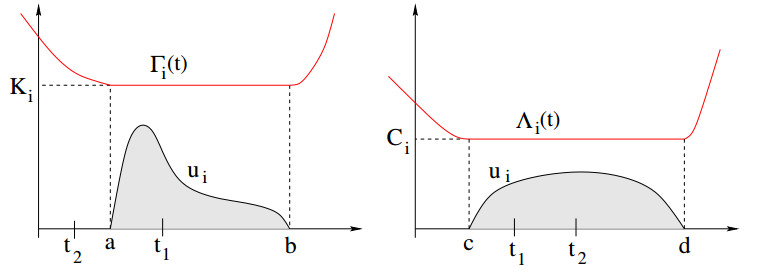









 DownLoad:
DownLoad:

